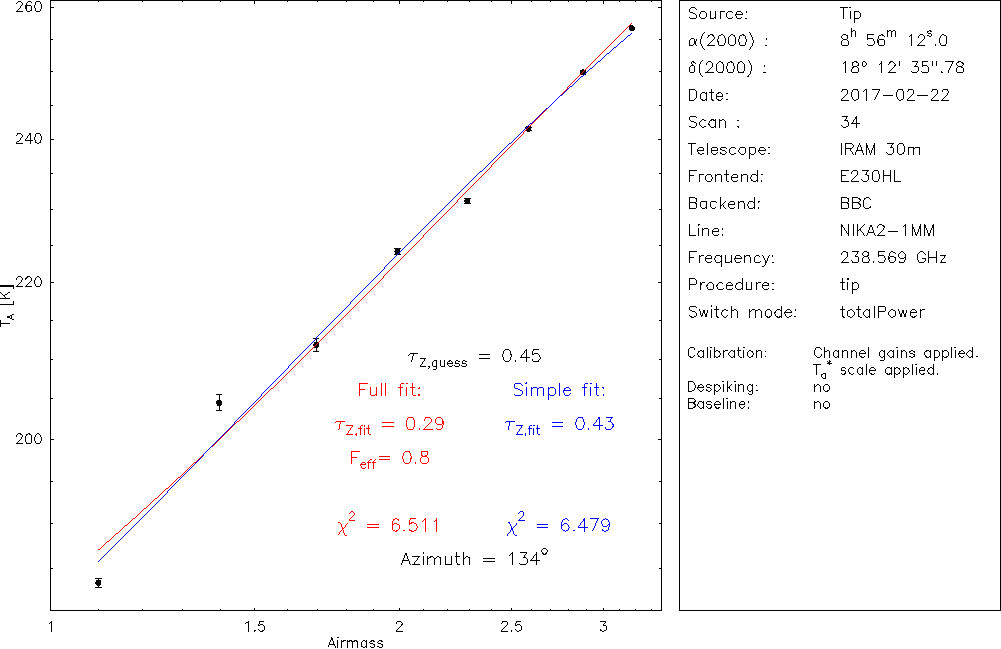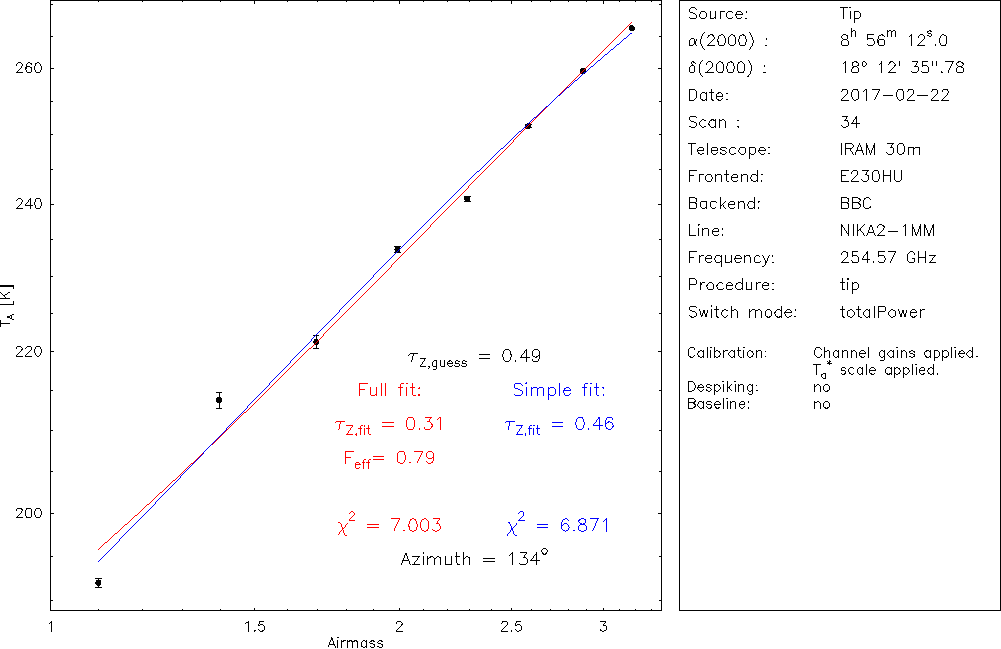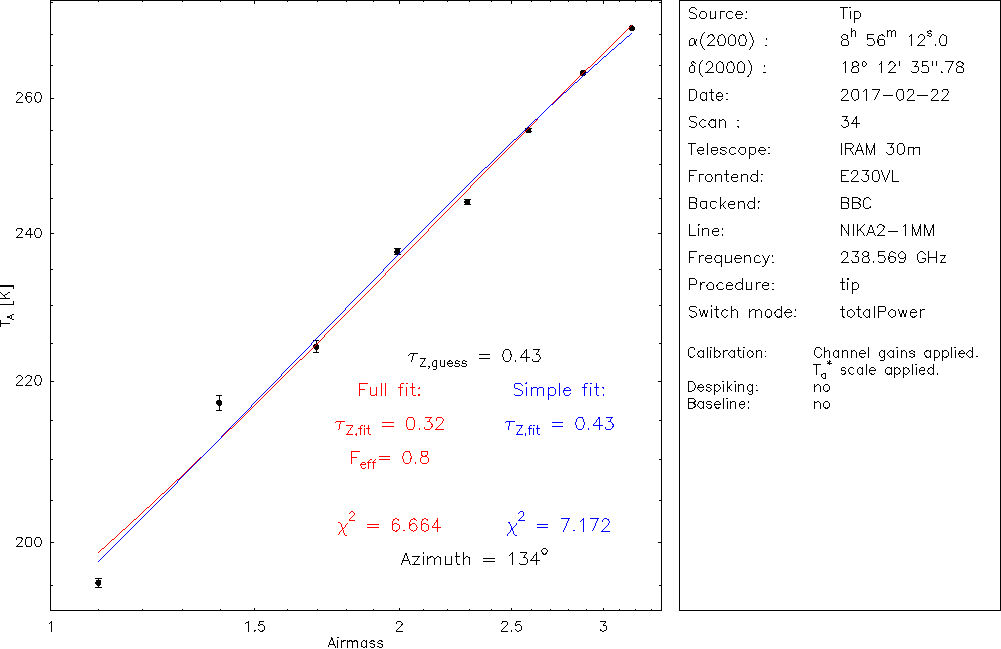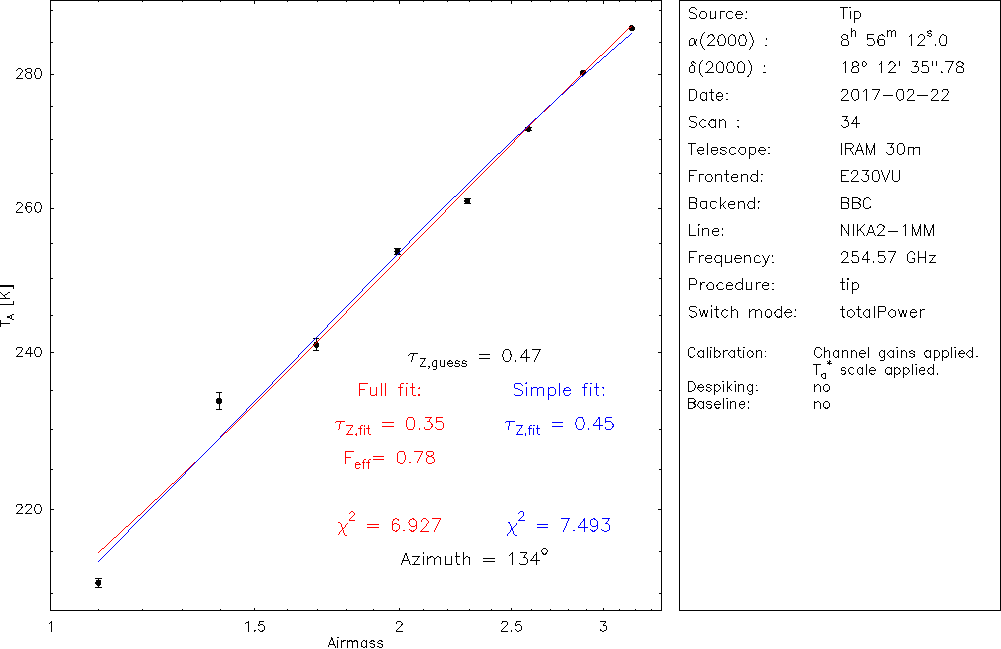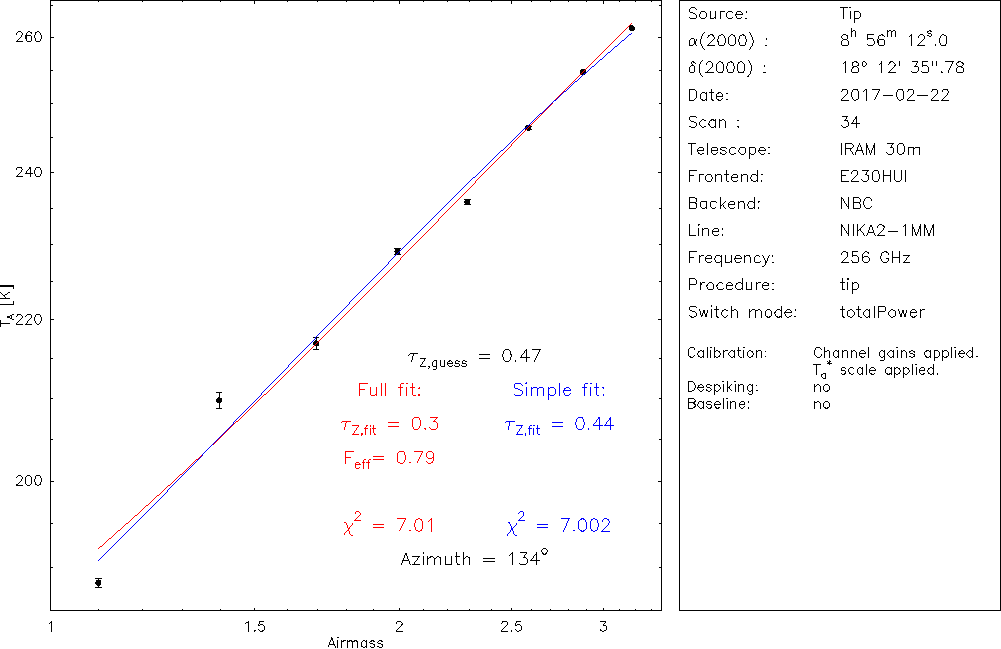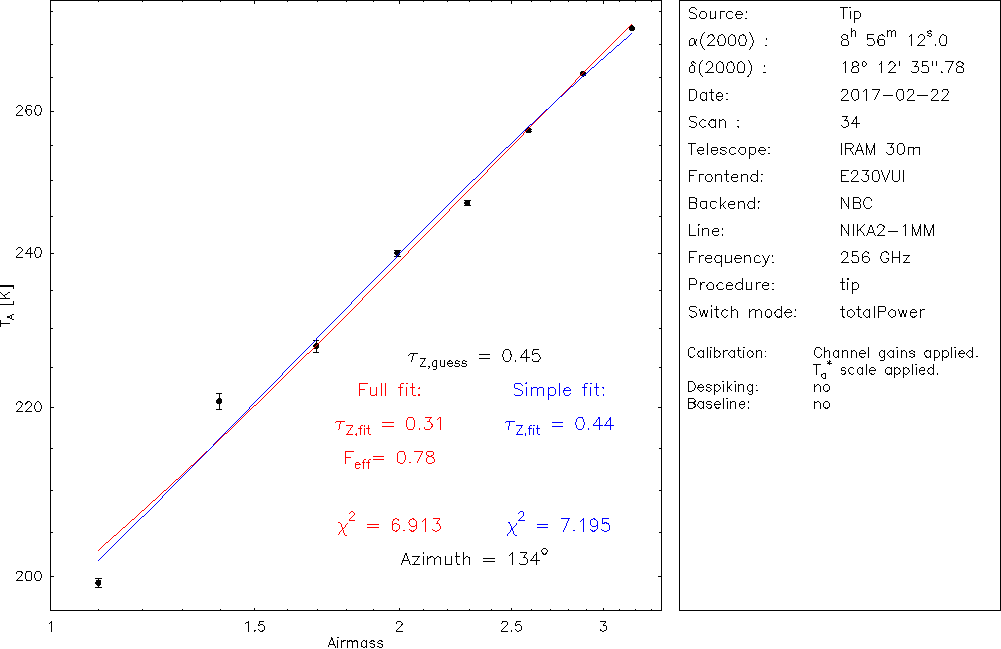|
Size: 1059
Comment:
|
Size: 2409
Comment:
|
| Deletions are marked like this. | Additions are marked like this. |
| Line 1: | Line 1: |
| = Skydip Observations with EMIR = '''Go to the [[http://www.iram.es/IRAMES/mainWiki/Continuum/NIKA2/Main| NIKA2]] main page.''' |
'''Go to the [[http://www.iram.es/IRAMES/mainWiki/Nika2Run9| Run9]] page.''' |
| Line 9: | Line 5: |
| = Skydip Observations with EMIR = | == Skydip Observations with EMIR == |
| Line 11: | Line 7: |
| 2017-02-22: two skydips were performed in both bands E1 & E2. The central frequency for each band was set to 151.60 GHz and 256.68 GHz (average of A1 & A3) after calculations of the effective frequency for the NIKA2 bands by J. Macias (A1 => 255.53 GHz, A2 => 151.60 GHZ, A3 => 257.84). The weather conditions were very similar for both measurements with pwv = 7 [mm]. Sccan numbers for the bands are: 26, 27 for E1 and 32, 34 for E2. The recorded bands are 4 BBCs (LSB & USB in HORIZONTAL & VERTICAL polarizations) and 2 NBC (USB in HORIZONTAL & VERTICAL polarizations). | '''General Procedure:''' two skydips were performed in both bands E1 & E2. The central frequency for each band was set to 151.60 GHz USB and 256.68 GHz USB (average of A1 & A3) after calculations of the effective frequency for the NIKA2 bands by J. Macias (A1 => 255.53 GHz, A2 => 151.60 GHZ, A3 => 257.84). The weather conditions were very similar for both measurements with pwv = 7 [mm]. A pointing (dAz = 3.7", dEl = 6.1") and focus (dFz = -2.0 mm) was perdormed on Mars to check the EMIR settings. Scan numbers for the bands are: 26, 28 for E1 and 32, 34 for E2. The recorded bands are 4 BBCs (LSB & USB in HORIZONTAL & VERTICAL polarizations) and 2 NBC (USB in HORIZONTAL & VERTICAL polarizations). The scans were reduced in MIRA following the procedure outlined [[http://www.iram.es/IRAMES/mainWiki/ListOfAstroTargetNika2Run9/test/ | here]]. Opacity results are given in the plots. |
| Line 13: | Line 9: |
| Results E1, s25: | '''2017-02-22''': |
| Line 15: | Line 11: |
| ||[[attachment:E1_BBC1_s26.png|E1_BBC1_s26]] || [[attachment:E1_BBC2_s26.png|E1_BBC1_s26]] || [[attachment:E1_BBC3_s26.png|E1_BBC1_s26]] || [[attachment:E1_BBC4_s26.png|E1_BBC1_s26]] || ||[[attachment:E1_NBC5_s26.png|E1_BBC1_s26]] || [[attachment:E1_NBC6_s26.png|E1_BBC1_s26]] |
Results E1, s26: {{attachment:E1_BBC1_s26.png|E1_BBC1_s26|width=500}} {{attachment:E1_BBC2_s26.png|E1_BBC2_s26|width=500}} {{attachment:E1_BBC3_s26.png|E1_BBC3_s26|width=500}} {{attachment:E1_BBC4_s26.png|E1_BBC4_s26|width=500}} {{attachment:E1_NBC5_s26.png|E1_NBC5_s26|width=500}} {{attachment:E1_NBC6_s26.png|E1_NBC6_s26|width=500}} Results E1, s28: {{attachment:E1_BBC1_s28.png|E1_BBC1_s28|width=500}} {{attachment:E1_BBC2_s28.png|E1_BBC2_s28|width=500}} {{attachment:E1_BBC3_s28.png|E1_BBC3_s28|width=500}} {{attachment:E1_BBC4_s28.png|E1_BBC4_s28|width=500}} {{attachment:E1_NBC5_s28.png|E1_NBC5_s28|width=500}} {{attachment:E1_NBC6_s28.png|E1_NBC6_s28|width=500}} Results E2, s32: {{attachment:E2_BBC1_s32.png|E2_BBC1_s32|width=500}} {{attachment:E2_BBC2_s32.png|E2_BBC2_s32|width=500}} {{attachment:E2_BBC3_s32.png|E2_BBC3_s32|width=500}} {{attachment:E2_BBC4_s32.png|E2_BBC4_s32|width=500}} {{attachment:E2_NBC5_s32.png|E2_NBC5_s32|width=500}} {{attachment:E2_NBC6_s32.png|E2_NBC6_s32|width=500}} Results E2, s34: {{attachment:E2_BBC1_s34.png|E2_BBC1_s34|width=500}} {{attachment:E2_BBC2_s34.png|E2_BBC2_s34|width=500}} {{attachment:E2_BBC3_s34.png|E2_BBC3_s34|width=500}} {{attachment:E2_BBC4_s34.png|E2_BBC4_s34|width=500}} {{attachment:E2_NBC5_s34.png|E2_NBC5_s34|width=500}} {{attachment:E2_NBC6_s34.png|E2_NBC6_s34|width=500}} |
Go to the Run9 page.
Skydip Observations with EMIR
General Procedure: two skydips were performed in both bands E1 & E2. The central frequency for each band was set to 151.60 GHz USB and 256.68 GHz USB (average of A1 & A3) after calculations of the effective frequency for the NIKA2 bands by J. Macias (A1 => 255.53 GHz, A2 => 151.60 GHZ, A3 => 257.84). The weather conditions were very similar for both measurements with pwv = 7 [mm]. A pointing (dAz = 3.7", dEl = 6.1") and focus (dFz = -2.0 mm) was perdormed on Mars to check the EMIR settings. Scan numbers for the bands are: 26, 28 for E1 and 32, 34 for E2. The recorded bands are 4 BBCs (LSB & USB in HORIZONTAL & VERTICAL polarizations) and 2 NBC (USB in HORIZONTAL & VERTICAL polarizations). The scans were reduced in MIRA following the procedure outlined here. Opacity results are given in the plots.
2017-02-22:
Results E1, s26:

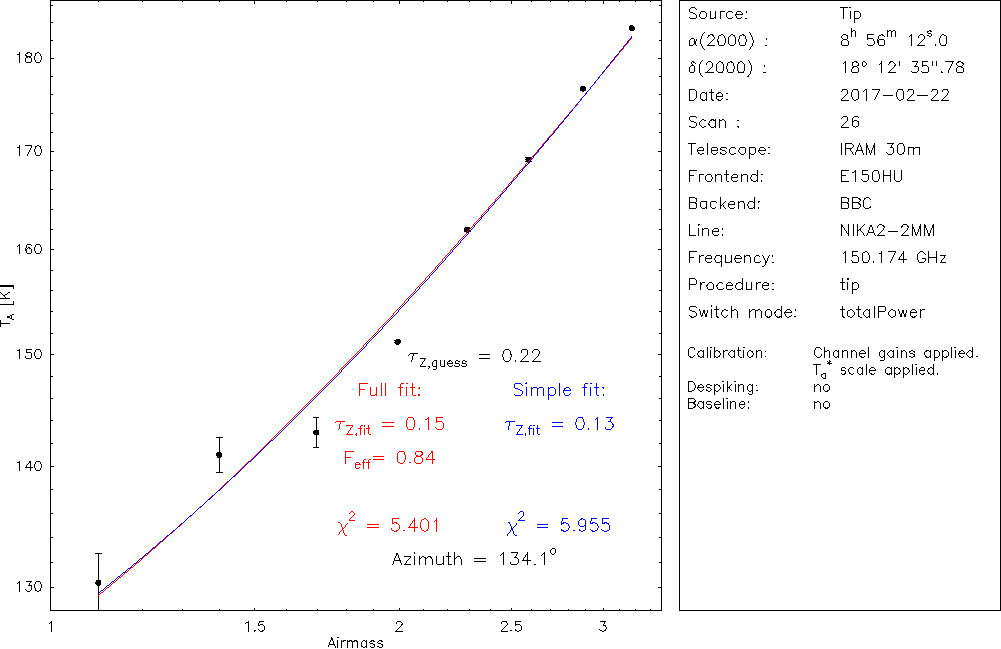
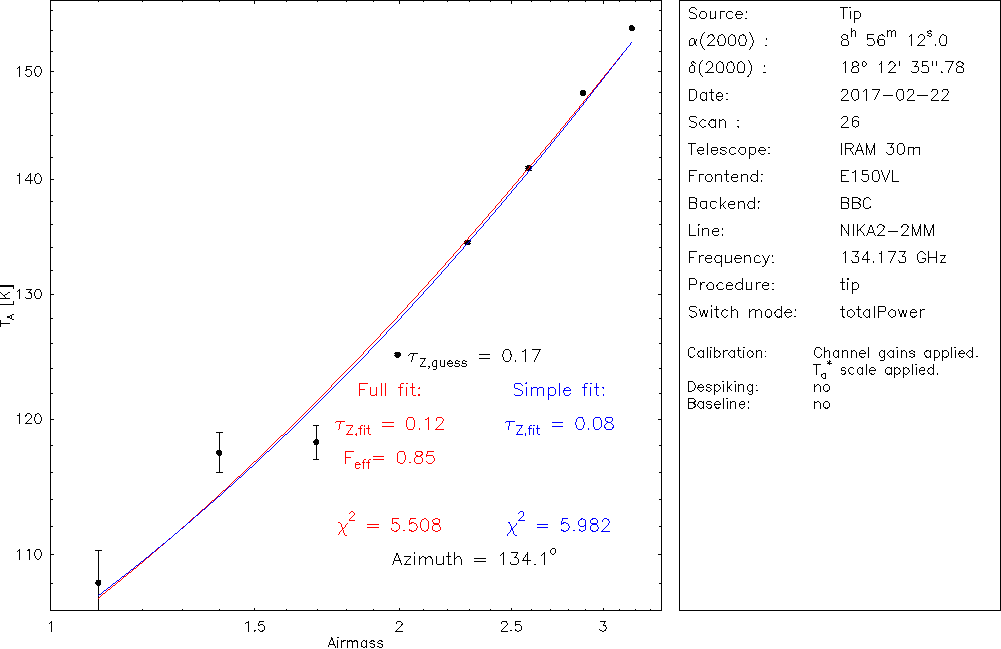
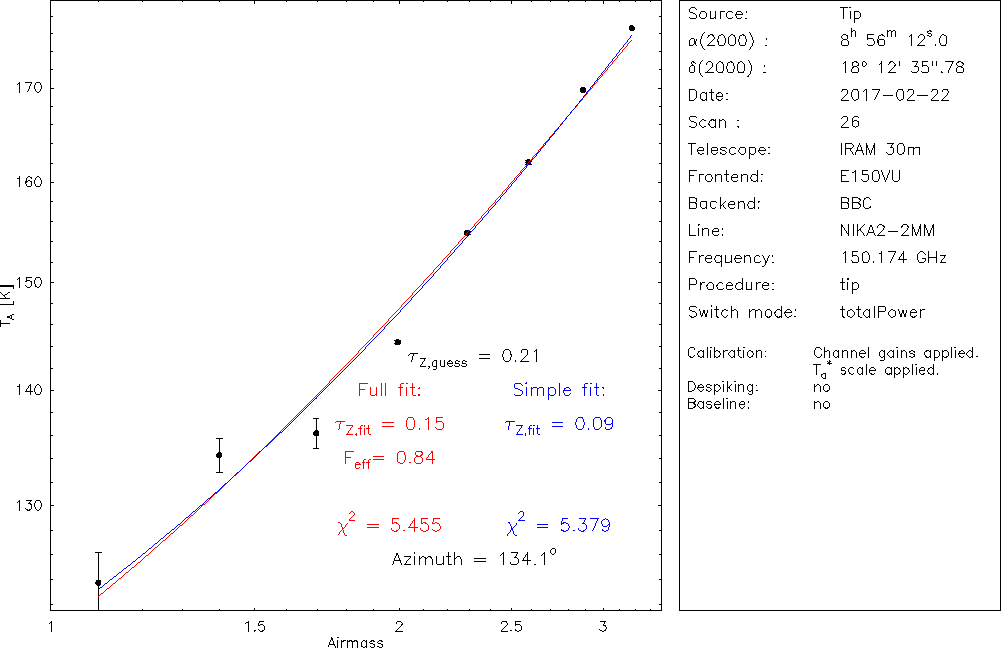

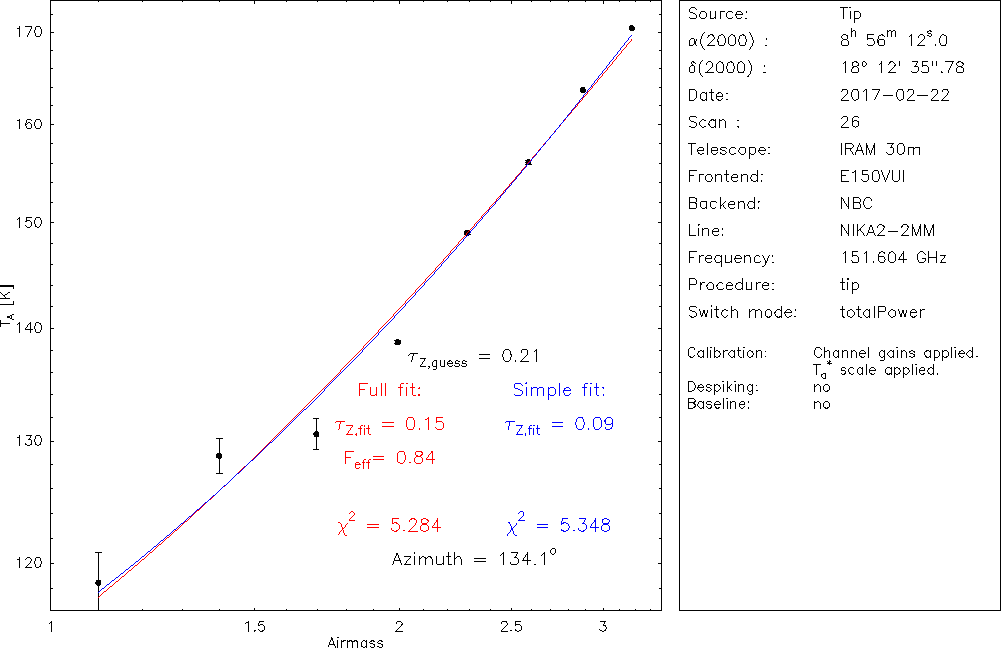
Results E1, s28:

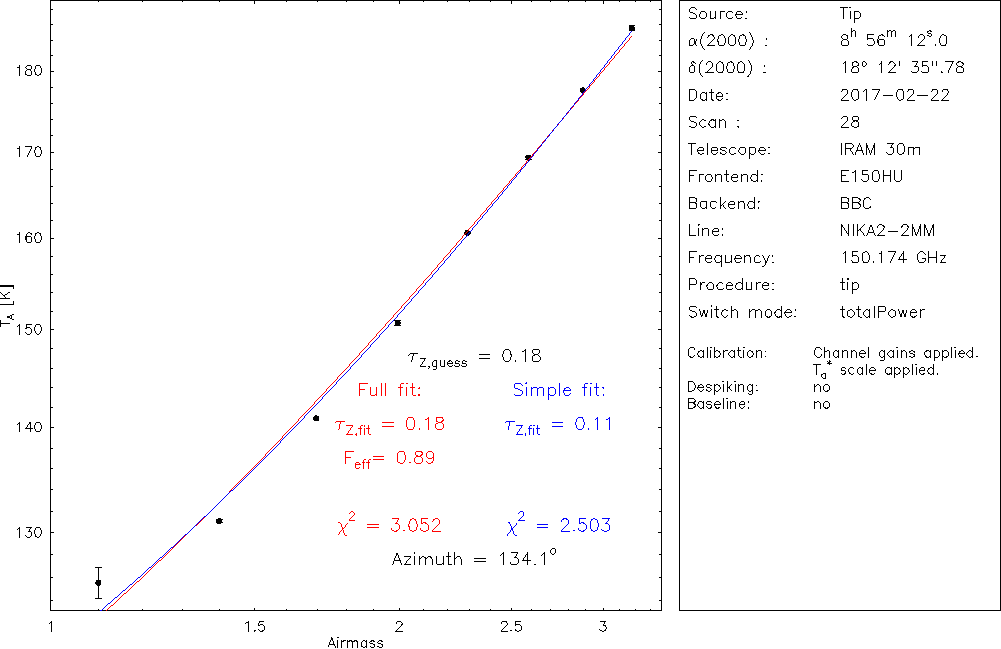
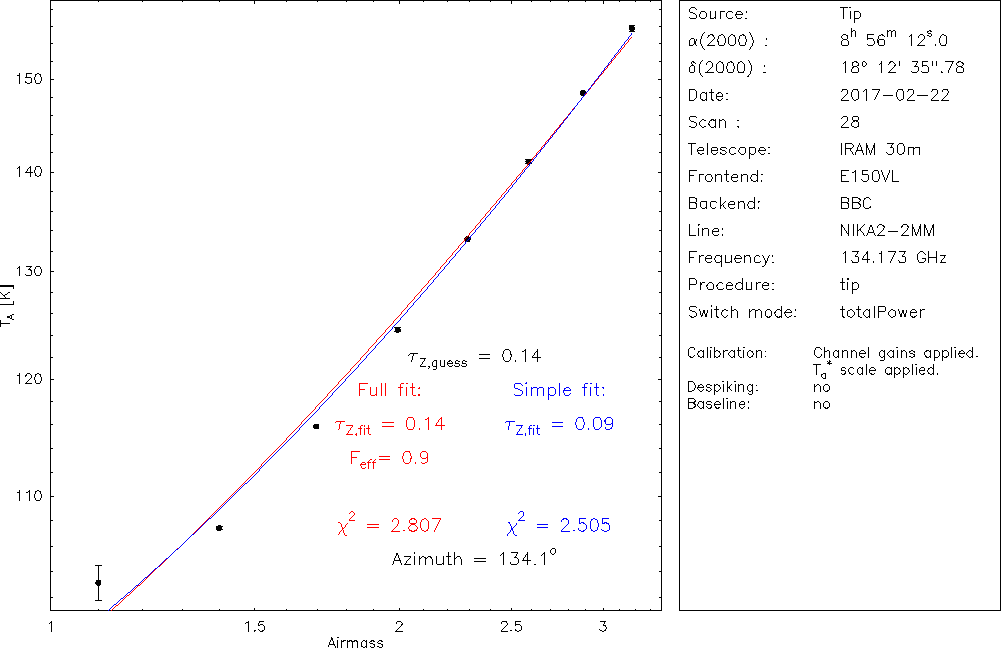
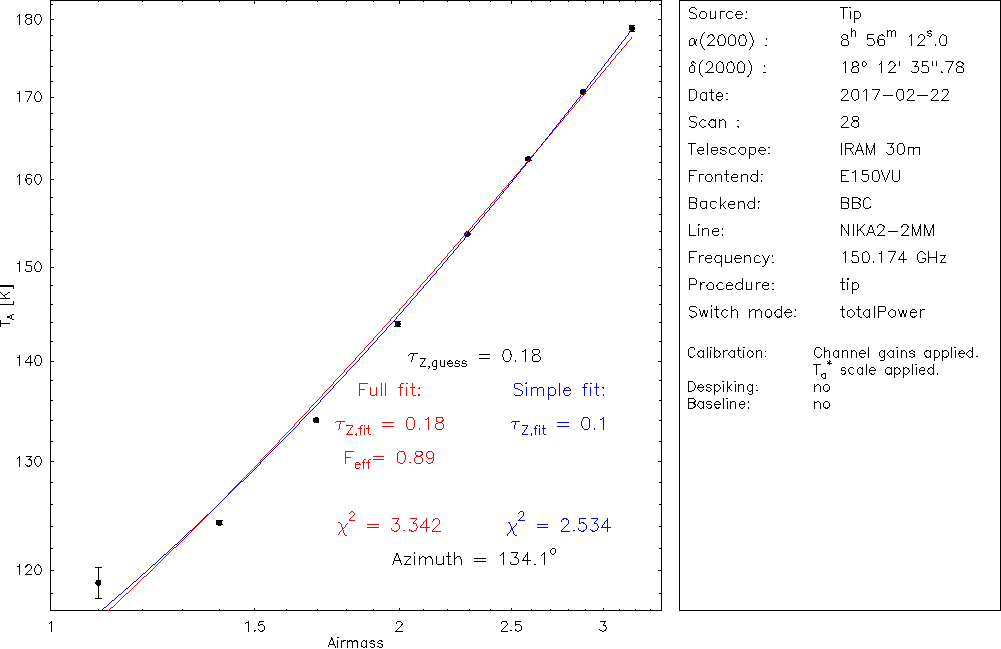
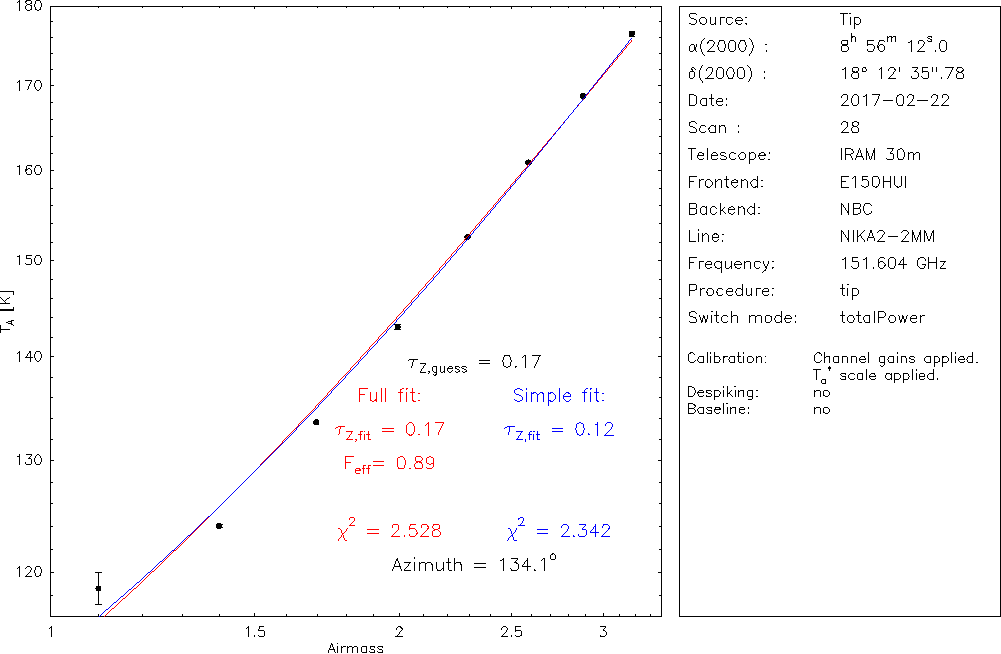
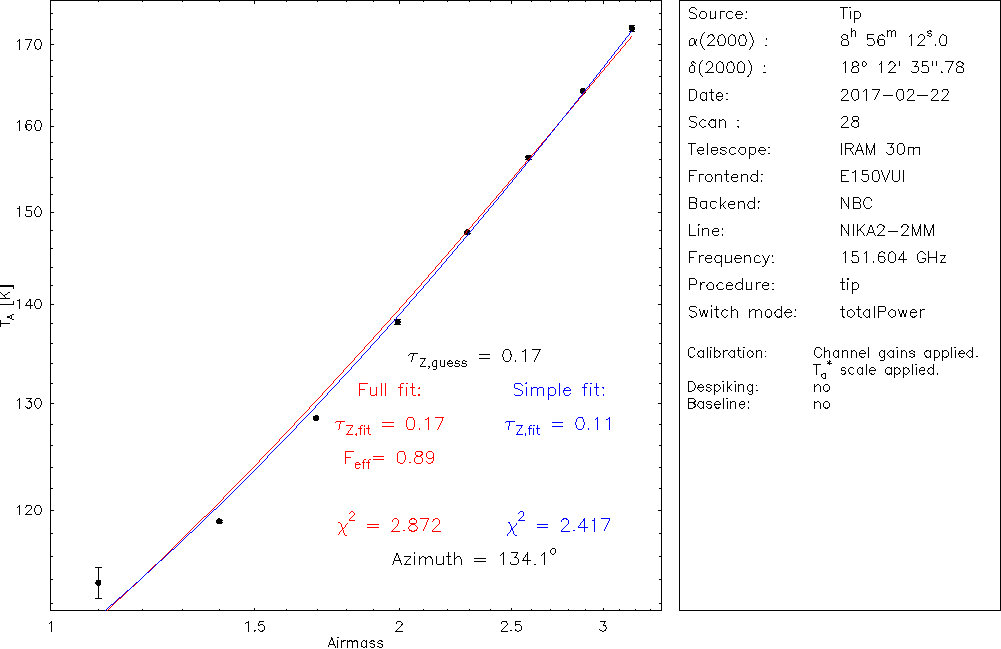
Results E2, s32:

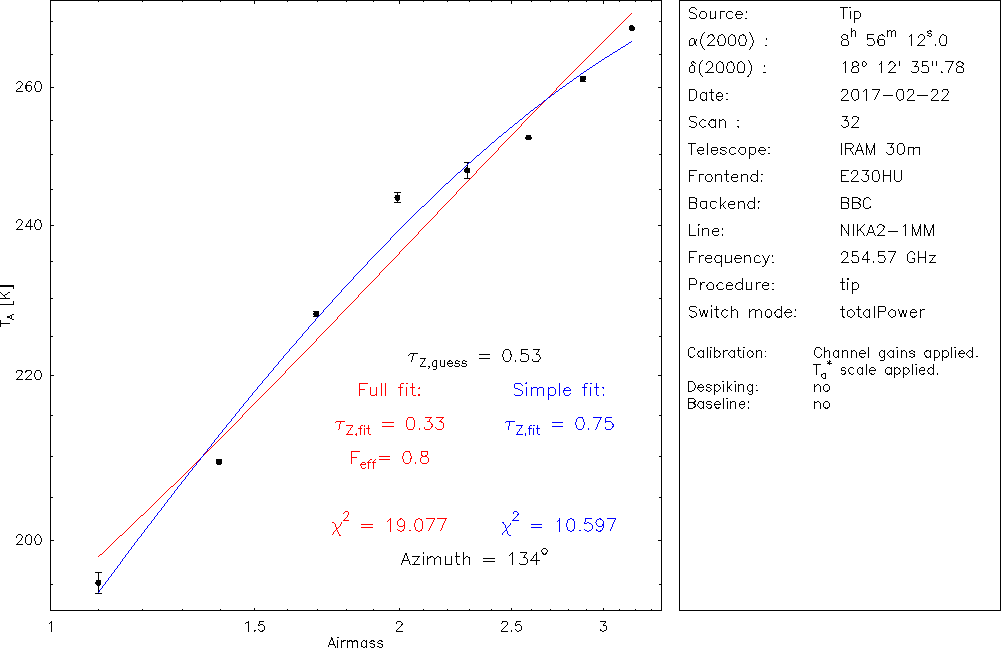
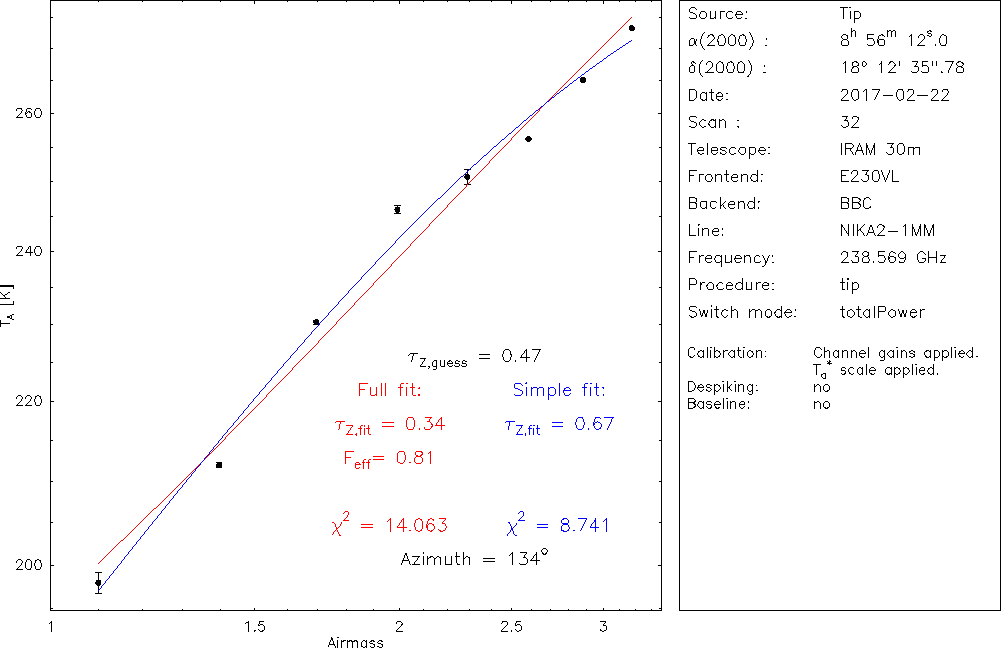
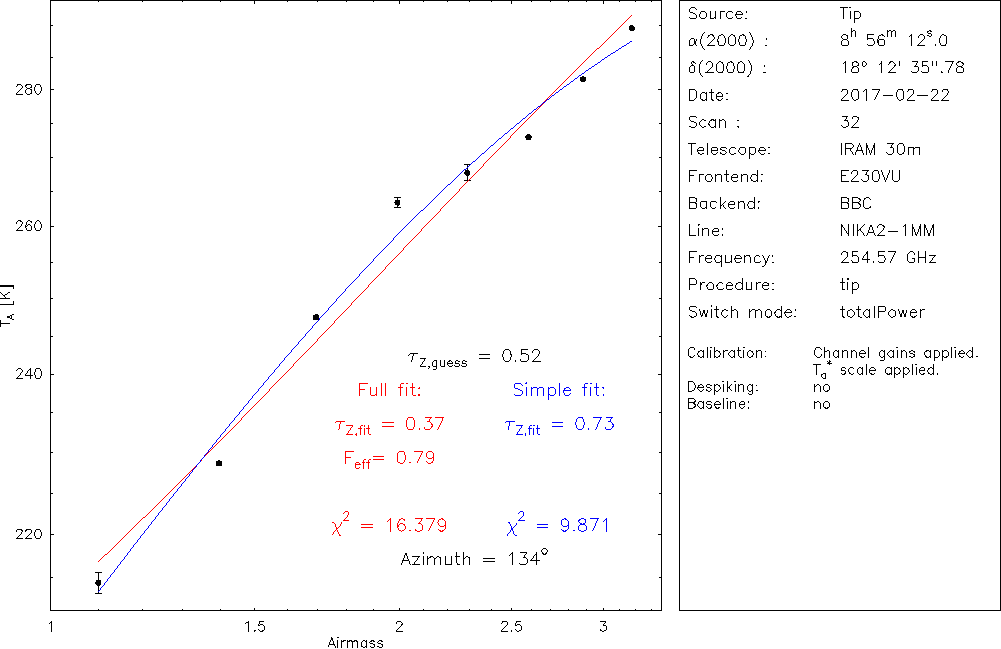
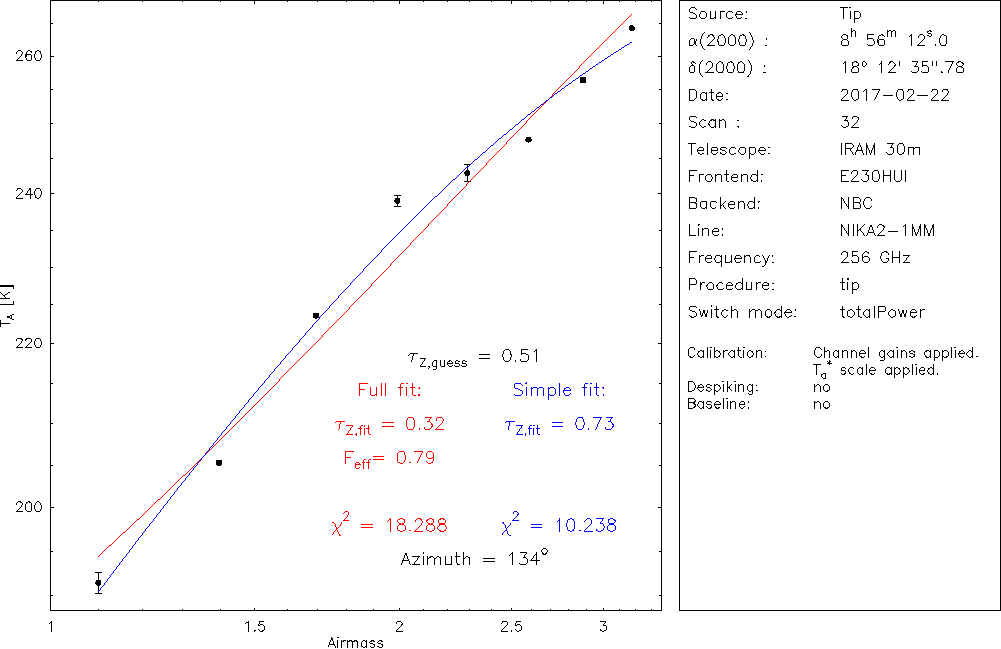
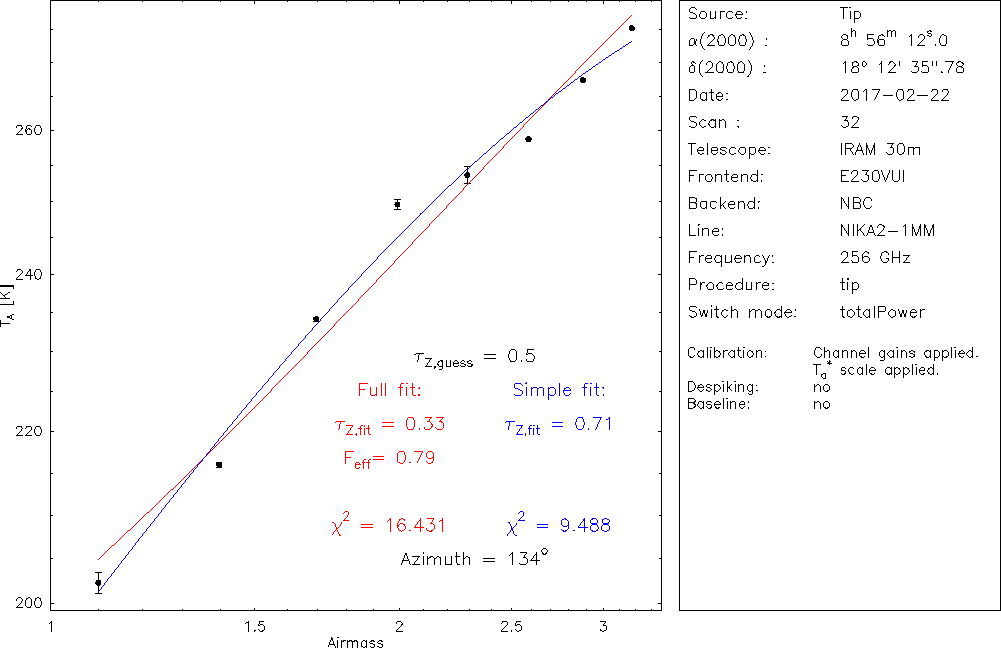
Results E2, s34:
